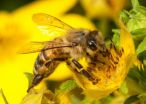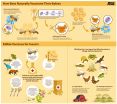(Press-News.org) Tempe, Ariz. -- When it comes to vaccinating their babies, bees don't have a choice -- they naturally immunize their offspring against specific diseases found in their environments. And now for the first time, scientists have discovered how they do it.
Researchers from Arizona State University, University of Helsinki, University of Jyväskylä and Norwegian University of Life Sciences made the discovery after studying a bee blood protein called vitellogenin. The scientists found that this protein plays a critical, but previously unknown role in providing bee babies protection against disease.
The findings appear today in the journal PLOS Pathogens.
"The process by which bees transfer immunity to their babies was a big mystery until now. What we found is that it's as simple as eating," said Gro Amdam, a professor with ASU's School of Life Sciences and co-author of the paper. "Our amazing discovery was made possible because of 15 years of basic research on vitellogenin. This exemplifies how long-term investments in basic research pay off."
Co-author Dalial Freitak, a postdoctoral researcher with University of Helsinki adds: "I have been working on bee immune priming since the start of my doctoral studies. Now almost 10 years later, I feel like I've solved an important part of the puzzle. It's a wonderful and very rewarding feeling!"
How it works
In a honey bee colony, the queen rarely leaves the nest, so worker bees must bring food to her. Forager bees can pick up pathogens in the environment while gathering pollen and nectar. Back in the hive, worker bees use this same pollen to create "royal jelly" -- a food made just for the queen that incidentally contains bacteria from the outside environment.
After eating these bacteria, the pathogens are digested in the gut and transferred to the body cavity; there they are stored in the queen's 'fat body' -- an organ similar to a liver. Pieces of the bacteria are then bound to vitellogenin -- a protein -- and carried via blood to the developing eggs. Because of this, bee babies are 'vaccinated' and their immune systems better prepared to fight diseases found in their environment once they are born.
Vitellogenin is the carrier of these immune-priming signals, something researchers did not know until now.
First edible vaccines for bees
While bees vaccinate their babies against some diseases, many pathogens are deadly and the insects are unable to fight them.
But now that Amdam and Freitak understand how bees vaccinate their babies, this opens the door to creating the first edible and natural vaccine for insects.
"We are patenting a way to produce a harmless vaccine, as well as how to cultivate the vaccines and introduce them to bee hives through a cocktail the bees would eat. They would then be able to stave off disease," said Freitak.
One destructive disease that affects bees is American Foul Brood, which spreads quickly and destroys hives. The bacterium infects bee larvae as they ingest food contaminated with its spores. These spores get their nourishment from the larvae, eventually killing them.
This disease is just one example where the researchers say a vaccine would be extremely beneficial.
Why this discovery is important to humans
It's widely known that pollinators, including bees, are facing serious environmental dangers.
During the past six decades, managed honey bee colonies in the United States have declined from 6 million in 1947 to only 2.5 million today. Not only are bees affected by diseases, they have been decimated by a phenomenon called colony collapse disorder. Researchers don't know exactly what causes this, but pesticides, pests, pathogens and nutrition problems may all be contributing factors.
According to a 2014 report by the U.S. government, pollinators are instrumental for a healthy economy and critical to food security, contributing 35 percent of global food production. In North America, insects pollinate 87 of the top 115 food crops and honey bees are vital in keeping fruits, nuts and vegetables in our diets.
Humans depend on bees and other pollinating insects for a huge portion of their food supply. Insect vaccines could play an important role in helping to combat colony collapse disorder, in addition to fighting a variety of diseases.
All egg-laying species have vitellogenin
This discovery could have far-reaching benefits for other species, as well as substantial, positive impacts on food production. All egg-laying species including fish, poultry, reptiles, amphibians and insects have vitellogenin in their bodies.
The food industry could implement the use of natural vaccines that would not only be inexpensive to produce, they could easily be used in developing countries.
"Because this vaccination process is naturally occurring, this process would be cheap and ultimately simple to implement. It has the potential to both improve and secure food production for humans," said Amdam.
INFORMATION:
This study was funded by several Academy of Finland grants 265971, 251337 and 252411, as well as Norwegian Research Council grants 180504 and 191699.
ASU School of Life Sciences is an academic unit of ASU College of Liberal Arts and Sciences.
Precise targeting biological molecules, such as cancer cells, for treatment is a challenge, due to their sheer size. Now ,Taiwanese scientists have proposed an advanced solution, based on a novel combination of previously used techniques, which can potentially be applied to thermal cancer therapy. Pei-Chang Tsai from the Institute of Atomic and Molecular Sciences, at the Academia Sinica, Taipei, and colleagues just published in EPJ QT an improved sensing technique for nanometre-scale heating and temperature sensing. Using a chemical method to attach gold nanorods to the ...
New research in mice shows that two commonly used gout medications, which target uric acid and adenosine triphosphate, may offer protection from alcohol-induced liver disease and inflammation. These findings suggest that clinical trials in humans with alcoholic liver disease should be considered. The report appears in the August 2015 issue of the Journal of Leukocyte Biology.
"This study should ultimately help patients with alcoholic liver disease to prevent and/or treat acute episodes of alcoholic hepatitis, a potentially lethal condition," said Gyongyi Szabo, M.D., ...
New research by scientists at the University of York has given tea and coffee drinkers new information about why their favourite drinks taste as they do.
The study led by Dr Seishi Shimizu, of the York Structural Biology Laboratory in the University's Department of Chemistry, shows that sugar has an important effect in reducing the bitterness of tea and coffee, not just by masking it but by influencing the fundamental chemistry.
The research published in Food and Function reveals new insights into the way in which caffeine, sugar and water interact at the molecular ...
While all human organs undergo normal, chronological aging, human skin undergoes an additional type of aging because of its direct contact with the environment. The environmental factor that ages human skin more than any other is UV radiation (UVR) from the sun, a process is called photoaging. Unlike chronological aging, which occurs exclusively with the passage of time, photoaging occurs when skin is repeatedly exposed to UV radiation from the sun.
Over time, the sun's ultraviolet (UV) light damages the fibers in the skin called elastin. When these fibers break down, ...
A synthetic membrane that self assembles and is easily produced may lead to better gas separation, water purification, drug delivery and DNA recognition, according to an international team of researchers.
This biomimetic membrane is composed of lipids -- fat molecules -- and protein-appended molecules that form water channels that transfer water at the rate of natural membranes, and self-assembles into 2-dimensional structures with parallel channels.
"Nature does things very efficiently and transport proteins are amazing machines present in biological membranes," said ...
Concerns about perfectionism can sabotage success at work, school or on the playing field, leading to stress, burnout and potential health problems, according to new research published by the Society for Personality and Social Psychology.
In the first meta-analysis of the relationship between perfectionism and burnout, researchers analyzed the findings from 43 previous studies conducted over the past 20 years. It turns out perfectionism isn't all bad. One aspect of perfectionism called "perfectionistic strivings" involves the setting of high personal standards and ...
(Boston)--A new way to detect - and perhaps treat - one of the deadliest types of breast cancer has been found.
Led by researchers at Boston University School of Medicine (BUSM), the study appears online in Breast Cancer Research.
Basal-like breast cancer (BLBC) is an aggressive form of breast cancer and is often referred to as "triple negative," which means it is not responsive to the common medical therapeutics. BLBC is more likely to metastasize - or spread to different areas of the body - quicker and earlier, and is associated with a poor prognosis. Women younger ...
Researchers at the Semel Institute for Neuroscience and Human Behavior at UCLA have found that a social skills program for high-functioning young adults with autism spectrum disorder significantly improved the participants' ability to engage with their peers.
In the study, the largest randomized controlled trial to show improved social functioning in young adults with autism, the participants' advances continued to be seen 16 weeks after the program's conclusion, and were even augmented by other improvements such as increased empathy and greater responsibility.
The ...
Babies conceived by women who drink alcohol around the time of conception face dramatically increased risks of type 2 diabetes and obesity in early middle age, a University of Queensland study has found.
The discovery was made by School of Biomedical Sciences scientist Associate Professor Karen Moritz during research into how events - particularly alcohol consumption - before and during pregnancy affect the long-term health of offspring.
Using a laboratory rat model, Dr Moritz and PhD student Ms Emelie Gardebjer discovered that the equivalent of five standard drinks ...
Precise targeting biological molecules, such as cancer cells, for treatment is a challenge, due to their sheer size. Now ,Taiwanese scientists have proposed an advanced solution, based on a novel combination of previously used techniques, which can potentially be applied to thermal cancer therapy. Pei-Chang Tsai from the Institute of Atomic and Molecular Sciences, at the Academia Sinica, Taipei, and colleagues just published in EPJ QT an improved sensing technique for nanometre-scale heating and temperature sensing. Using a chemical method to attach gold nanorods to the ...


